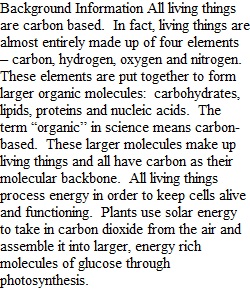


Q Carbon Cycle Activity Background Information All living things are carbon based. In fact, living things are almost entirely made up of four elements – carbon, hydrogen, oxygen and nitrogen. These elements are put together to form larger organic molecules: carbohydrates, lipids, proteins and nucleic acids. The term “organic” in science means carbon-based. These larger molecules make up living things and all have carbon as their molecular backbone. All living things process energy in order to keep cells alive and functioning. Plants use solar energy to take in carbon dioxide from the air and assemble it into larger, energy rich molecules of glucose through photosynthesis. This sugar is then broken down by all living things through cellular respiration. Energy released from the breakdown of the sugar during cellular respiration is used to produce ATP (adenosine triphosphate), cellular energy. All cells require ATP to perform work to function. These two processes make up a major part of the carbon cycle. Questions: 1. Write the equation for photosynthesis. 2. How does the plant get the reactants (things on the left side of the equation)? 3. What happens to the products (things on the right side of the equation)? 4. Which organisms in general, undergo photosynthesis? 5. Write the equation for cellular respiration. 6. How would you get the reactants into your body? 7. What happens to the products in an animal? 8. Which organisms in general, use cellular respiration (be careful!)? Carbon Cycle Interactive Diagram Carbon travels throughout the ecosystem and spends time in the air, water, rocks, and tissues of living and dead organisms. The diagram depicts carbon stores in gray. These are also called carbon sinks. These sinks remove carbon from the atmosphere and store it. Plants remove carbon from the atmosphere and use it to build their tissues during photosynthesis. Therefore a forest would be considered a carbon sink. When vegetation burns, this carbon is released back into the atmosphere. Click on the various components of the diagram to answer the following questions. Questions 1. What molecules make up atmospheric carbon? 2. List the processes that add carbon to the atmosphere. 3. List the processes that remove carbon from the atmosphere. 4. Which parts of the cycle would be considered a carbon store (or sink)? 5. What are phytoplankton? How do they play a role in carbon sequestration (removing and storing atmospheric carbon)? 6. What are fossil fuels? 7. How are they contributing to atmospheric carbon dioxide? Climate Change and Carbon Carbon dioxide is a greenhouse gas. This means that it traps heat in the atmosphere. A certain amount of carbon dioxide is necessary, but is now much higher than any time in the past, causing the climate to warm. Human activities, mainly the burning of fossil fuels, have contributed greatly to the rise in atmospheric carbon dioxide. Fossil fuels include coal, oil and natural gas. They are plants that have been trapped in the Earth’s crust and fossilized over thousands of years. Because they are carbon based, they are energy rich. We now use them for energy. Coal is used in power generation, oil is refined to produce gasoline, and natural gas is mainly used in home heating. Go to the NASA climate webpage and answer the following questions: https://climate.nasa.gov Questions Facts/Evidence 1. Look at the graph of carbon dioxide levels over the last 650,000 years. How do levels today compare with those throughout history? 2. As you scroll down, what nine pieces of evidence are listed? Facts/Causes 1. What is the greenhouse effect? 2. Which gasses are responsible for the greenhouse effect? 3. How have human activities altered the greenhouse effect? Facts/Effects 1. List the future effects of climate change as listed on the “effects” page. 2. Specifically, what effects should the southwest expect? Facts/Vital Signs 1. What is the trend for both atmospheric carbon dioxide and global temperature? 2. What two factors are causing sea level increase?
View Related Questions